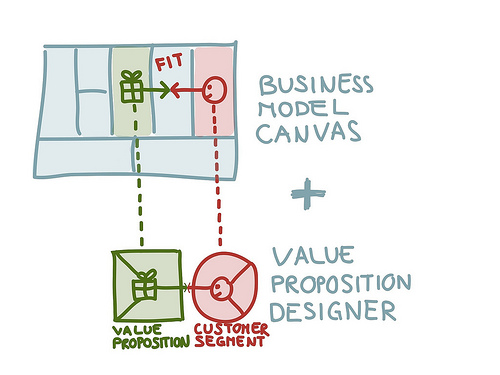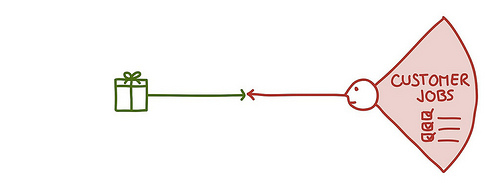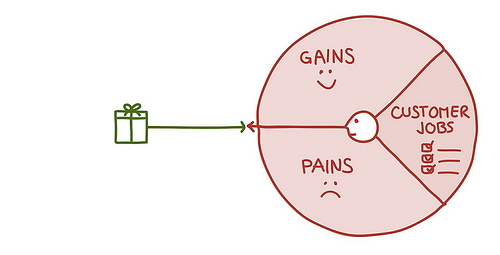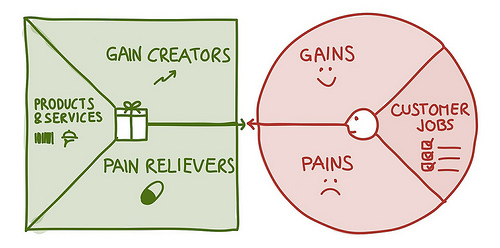How to achieve conformity of the product to the market with new canvas value proposition
Outline of the proposed values is really a addition to Canvas business model. She helps to design, test, and shape offer consumers value a more structured and sophisticated method is exactly the same as the Canvas business model helps in the process of developing a business model (I previously wrote how we came up with this new tool).
Canvas business model with its 9 constituent blocks focuses on the big picture. Outline the proposed values examines two of these units – we offer value and a segment of the buyer, allowing to describe and to analyze in more detail the "match" between them. Companies need to achieve the correct matching, and the right business model if they don't want to burn what I wrote earlier in the post about failure. These tools work best in combination. One does not replace another.

In this post I will talk about this conceptual tool. In your next post, I will explain how it can be used in testing in conjunction with the methods of development of the client Steve blank lean startup Eric Rice. Outline the proposed values will allow us to better describe the hypotheses on the proposed values and consumers to prepare for interviews with consumers and will be a guide for testing and changes.
the Outline of the proposed values
As noted earlier, the Outline of the proposed value consists of two blocks of the Canvas business model: the proposed values and the corresponding segment of consumers to which you are applying. The purpose of the tool is to help you more specifically describe each of them using a simple but effective structure. This rendering helps to improve strategic communication and prepares to test both units.
Achievement
The purpose of the Outline of the proposed values is to help you develop great offer values that correspond to the needs and objectives of your consumers and allow them to solve their problems. Is that in the context of startups called the product market or line of solutions to the problem. Outline of the proposed value helps to apply a more systematic approach to achieve compliance.

user Tasks
First, let's have a closer look at the consumer and sketching his portrait. I want you to notice three things. Start with a description of what your target consumers are trying to do. It could be the tasks they are trying to accomplish, problems they trying to solve, or the needs they try to satisfy.

Ask yourself:
the
- What emotional task your trying to accomplish the consumer? (e.g. aesthetics, well-being, safety, ...)
What function is trying to execute your customer? (for example, to perform a specific task, solve a specific problem, ...)
What are the social tasks of trying to fulfill your consumer? (for example, tries to look good, trying to gain credibility or status, ...) the
What are the main needs trying to satisfy your consumer? (e.g. communication, sex, ...)
the"Pain" of the consumer
Now describe negative emotions, undesired costs, situations and risks that occur or could occur before the consumer before, during or after task execution.

Ask yourself:
• What will your user find too costly? (for example, that requires a lot of time, costs too much money, requires substantial efforts, ...)
• What makes your customer feel bad? (for example, grief, anger, things that cause a headache, ...)
• What current solutions do not suit your consumer? (for example, lack of functionality, performance, poor performance, ...)
• What are the main difficulties and problems faced by your customers? (for example, a lack of understanding of how everything works, the complexity of the implementation, opposition, ...)
• What negative social consequences faced or afraid to face your consumer? (for example, loss of reputation, credibility, trust, status, ...)
• What risks your customer fears? (e.g., financial, social, technical, something can go completely wrong, ...)
• What your consumer is not sleeping through the night? (for example, large problems, experiences, anxieties, ...)
• What are common mistakes of your consumer? (for example, usage errors ...)
• What barriers keep your customer from adopting solutions? (for example, the cost of initial investment, learning curve, acceptance of change, ...)
Rank each pain according to its intensity from the point of view of the consumer. Is it very strong or very weak? For each "pain" note how often it occurs.
Advantages for consumers
Now amazed of the benefits that your customer expects, desires or would be surprised to. This includes functional, social gains, positive emotions, and cost savings.

Ask yourself:
the
-
the
- Savings are what will make your customer happy? (e.g., time, money, effort, ...) the
- Any expectations of your consumers and what can exceed his expectations? (e.g. quality level, more of something, less of something, ...) the
- like your consumer in current solutions? (e.g. specific function, performance, quality, ...) the
- That would have simplified the work or the life of your customer? (for example, smoother learning curve, more services, lower cost of ownership, ...) the
- What positive social consequences of wish to your consumer? (for example, to look good, to enhance the authority, increase status, ...)
- To increase the likelihood of implementation of the decision? (for example, reducing the cost, investment risks; improving the quality, performance, design, ...)
- do they provide savings? (for example, in the form of time, money, effort, ...) the
- whether they improve the emotional state of your customers? (for example, clean up grief, anger, things that bring a headache, ...) the
- if they fix the flaws of existing solutions? (e.g., new features, improved performance, improved quality, ...) the
- removed if they of difficulty or problem faced by your consumer? (for example, that simplify, help to make, reduce resistance, ...)
- they reduce the risks that you fear your consumers? (e.g., financial, social, technical, something can go very wrong, ...) the
- do they help your customers sleep better at night? (for example, help to solve big problems, reduce fear, relieve worries, ...) the
- restrict or eradicate if they are common errors that allow consumers? (for example, errors of usage, ...)
- do they provide savings that make your customer happy? (for example, in the form of time, money, effort, ...) the
- copy or whether they outperform current solutions that satisfy your customer? (for example in relation to specific functions, performance, quality, ...) the
- simplify their work or life of the consumer? (for example, smoother learning curve, usability, accessibility, more services, lower cost of ownership, ...) the
- do they provide positive social effects, which wishes to obtain the consumer? (for example, allow it to look better, provide greater credibility, status, ...) the
- do they give something that wants to get your consumer? (e.g. good design, guarantees, specific functions or extension functions, ...) the
- whether they have any dreams of consumers? (for example, contribute to greater achievements, provide great relief, ...) the
- do they give positive results, relevant to the criteria of success and failure of a consumer? (for example, productivity increase, cost reduction, ...)
What are your customers looking for? (e.g. good design, guarantees, specific functions or extension functions, ...)
the dream Of the consumers? (e.g. big achievements, big relief,)
How your customers measure success and failure? (e.g., performance, cost, ...) the
Rank each advantage from the point of view of importance for the consumer. Is it necessary or irrelevant? Indicate how often each advantage.
Products and services
Now that you've sketched out a portrait of the consumer, let's move on to the proposed values. Again, I want you to notice three things. First, list all the products and services around which to build your offer value.

Ask yourself which of your proposed products and services help your customers to achieve functional, social or emotional tasks or meet basic needs.
Products and services can be tangible (e.g. manufactured goods, personal customer service), digital/virtual (e.g. downloads, online recommendations), intangible (e.g. copyrights, quality assurance), or financial (e.g. investment funds, financial services).
Rank all products and services according to their importance to your customer. Are they vital or insignificant to your customer?
"Pain"
Now let's describe how your products and services create value. First, describe how your products and services "ease the pain" of the consumer. As they eliminate or reduce negative emotions, undesired costs or situation, and the risks that carries, or can carry your consumer before, during and after task execution.

Ask yourself regarding products and services...
the
-
the
if they eliminate negative social consequences, which occur or which are afraid of your clients? (for example, loss of reputation, credibility, trust, status, ...) the
if they eliminate the barriers that keep your customers from implementing solutions? (for example, reducing or eliminating initial investment, has a smoother learning curve, less resistance to change, ...)
Rank each pain, which deliver your products and services in intensity from the point of view of your consumer. She is very strong or very minor? For each "pain" note how often it occurs.
benefits
Finally, describe how your products and services create benefits for the consumer. They create an additional benefit that expects, desires or would be surprised to your customer, including functional, social benefits, positive emotions and cost savings.

Ask yourself regarding products and services...
the
-
the
they simplify the implementation process? (for example, cost reduction, investment and risk; improve quality, performance, design, ...)
Rank each advantage that create your products and services in order of importance to your customer. It significant or insignificant? Indicate how often each advantage.
Competition for customers
Most of the proposed values compete with each other for the same consumer segment. I like to think of it as an "open niche" that fill the company that offered the best fit. This visualization was the idea of Alan Smith, one of my co-founders and the developer of the generation business models.

If you outline the proposed alternative values, you can easily compare them, working with the same variables (e.g. price, performance, risk, service quality etc.) on the so-called strategic framework.

Poster Canvas offer values
You can use the Outline of the proposed values in the same way as the Canvas business model: print a poster, attach to the wall and use the stickers to describe.
Unlike the Canvas of the business model poster and methodology Outline the proposed values are protected by copyright. However, you can freely use it and earn money on it as an entrepreneur, consultant, or supervisor if you are not affiliated with the company-software developer (in this case, you must obtain a license from us). When using, please refer to BusinessModelGeneration.com.
Below are downloadable version poster Canvas offer values.
Testing changes
The use of the Canvas offer value as a tool for reflection and design is only the beginning. To get the most out of it, you must also use the testing and changes. In your the next post I will explain how you can perfectly match the Outline of the proposed value with process development and lean startup. I will tell you what essential the help she can provide, when you "come out of the offices and communicate with their customers," as it would be called Steve Blank.
Along with the "offer value" are alternative translations: tsennosti offer, a core value, the dignity of the proposal. They are all a translation of the English "Value Proposition"
the Translation is done in the framework of the summer school start-UPS Tolstoy Summer Camp.
Комментарии
Отправить комментарий